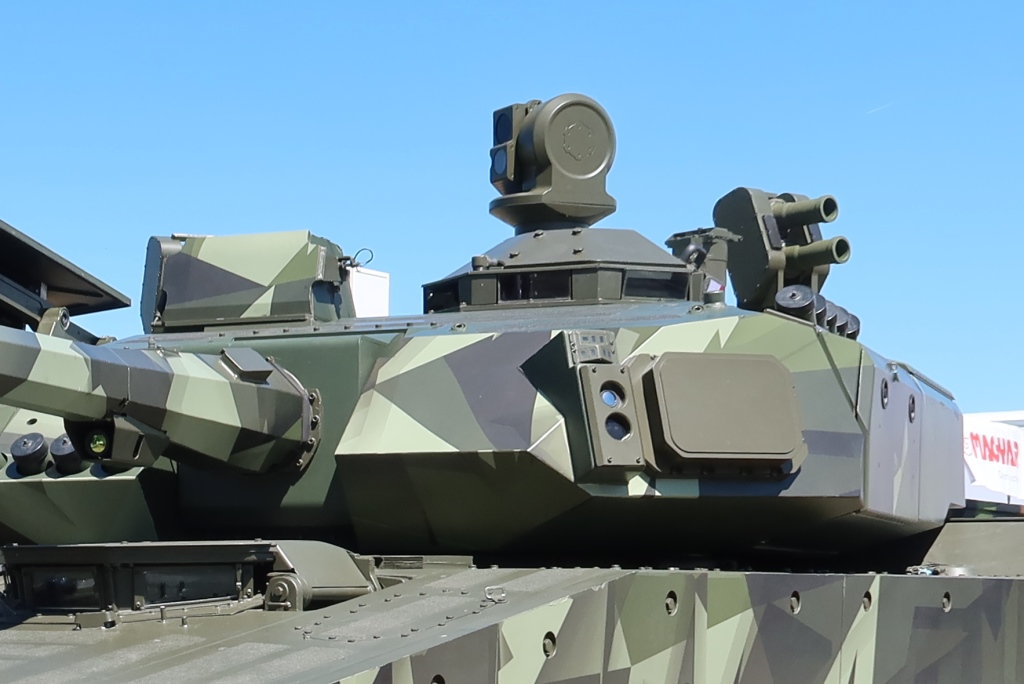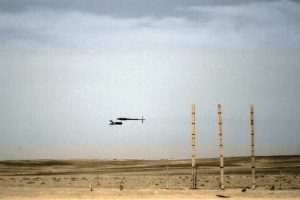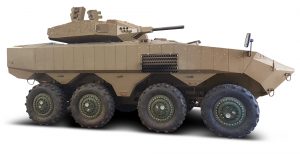
Elbit Systems Iron Fist
Another Israel champion in the APS world is Elbit Systems, which developed the Iron Fist, also a turret-based system, and which provided the latest details at the International Armorued Vehicles conference rganised by Defence iQ in London in late January. Here too we find two two-barrel launchers capable to shoot an effector with a mortar-like propulsion system, firing data being provided by a main computer which is fed with data by the distributed sensors, in the form of four radars and the same number of electro-optics working in the Long Wave InfraRed (LWIR) band. Once identified the threat the system switches from search to track mode, acquires information on the threat, threat analysis and characterisation being ensured by high speed computing technology and AI-based algorithms. Initial data are loaded in the interceptor fuse, allowing to accurately trim the detonation timing, which according to the company is even more crucial than azimuth, as it is key in disrupting the jet of the shaped charge. The same should apply to KE threats, where timing is even more critical as combined velocity is of approximately 2,000 m/s.
Reaction time is compatible with defeating shaped charge and kinetic energy threats both with soft-kill (SK) and hard-kill (HK) effectors. According to Elbit the Iron Fist can neutralise an RPG launched at 50 meters distance from the protected vehicle. In order to avoid high peak energy consumption the two launcher control units are fitted with capacitors that are kept loaded at all time, allowing launching the HK munition without drawing energy from batteries or alternator.
EDR On-Line understood that interceptor munitions are based on shock wave which brakes the envelope of the incoming shaped charge projectiles or destabilised the long rod.

The issue of reduction of residual penetration was stressed at the presentation, this being influenced by three parameters, threshold of pressure exercised on the threat, longitudinal location of the countermeasure’s shock wave impact on the threat and interception range from the platform. In order to comply with the requirement for low residual penetration, the working point of Iron Fist is being optimized in terms of triggering accuracy and shock wave activation, to ensure the high pressure needed to prevent the formation of the jet, or its disturbance if activated. APS effectiveness is typically measured according to a rolled homogeneous armour (RHA) target and test setup, and characterizes the level of protection based on the measured residual penetration of the RHA target. EDR On-Line understood that most rocket and missile threats effectiveness can be reduced to really marginal levels.
Originally the Iron Fist was more an integrated system, with all-in one elements, however to improve integration and upgrade capacities Elbit has since made it as a modular and open architecture system with separated line replaceable units (LRU) that allows easy LRUs replacement. The is currently available in two versions, the IFLK (Iron Fist Light Kinetic) aimed at tanks and heavy IFVs and capable to provide protection also from KE also thanks to the passive armour protection level typical of those vehicles, and the IFLD (Iron Fist Light Decoupled) for light to medium IFVs, which does not take into consideration the KE threat coming from long rods fired from tank guns.
Salvo attacks carried out with antitank rocket and missiles, aimed at overcoming the APS capability, are a reality. A video shown at the IAV conference highlighted how both RPGs launched in split-second time were intercepted by the Iron Fist in “fractions of seconds”, no numbers being provided. As for long rods Elbit underlined that the aim here is to destabilise them in order to modify the angle of attack, to reduce nominal penetration by up to 90%, which was well shown by a movie shown during the presentation.
It is to note that the Iron Fist can be fitted with laser effectors, which provide a SK capability. A video projected at the IAV conference showed two second generation missiles shot at a Merkava Mk 4 diverted by the Iron Fist laser jammer at 1 km distance. The laser jammer is fitted together with the launcher unit and can therefore be oriented in azimuth and elevation according to needs. It is highly probable that an energy storage system like the one used for the launcher is adopted in order to avoid energy consumption peaks. Elbit underlines that the amount of data gathered by the Iron Fist sensors allow to use the laser for a series of other missions, experiments being ongoing with the IDF but these remain classified. C-UAS should certainly fall within the laser capabilities
Coming to this self-defence capability that has become key following recent conflicts in eastern Europe, Iron Fist sensors can detect a drone or a loitering munition at around 1.5 km range, according to the company, distributing the information through the network to all actors in the field. As well as other companies, also Elbit Systems considers its APS the last resource, to be used when SK systems such as EW, then lasers and RCWS failed to stop the threat. Videos were shown taken at the company proving ground, in the Negev desert, where the Iron Fist interceptor successfully engaged drones simulating loitering munitions attack profiles.

The IDF selected the Iron Fist for its new Eitan IFV, a completes a series of successful interception tests having been carried out in late 2022 by the Israel MoD Tank and APC Directorate, IDF Ground Forces, and Elbit Systems Land Division. The Eitan should be soon delivered to IDF operational units. The Iron Fist is also due to be installed on the D9 armoured bulldozer an on the new turreted version of the Namer IFV.The Elbit Systems APS has been tested also abroad. The system was selected by the Dutch Army on its CV9035NL and is being offered by BAE Systems Hagglunds for the armies of the Slovak Republic and the Czech Republic. Recently the US Army announced that in October a series of tests was successfully conducted with the IFLD installed on a Bradley IFV, to verify system improvements since a first round of tests carried out in 2018. The US Army aims at equipping an entire Army brigade of Bradley vehicles in 2025. The Elbit APS was also recently successfully tested in Australia, where it is expected to be integrated under Land400 Phase 2 (Boxer CRV) and 3 (tracked IFV still to be selected) programmes.
Photos courtesy Elbit Systems and P. Valpolini



